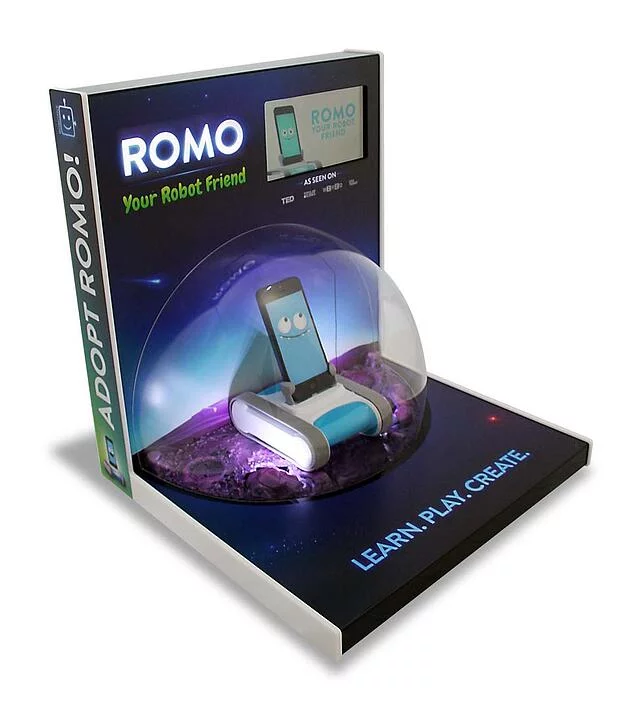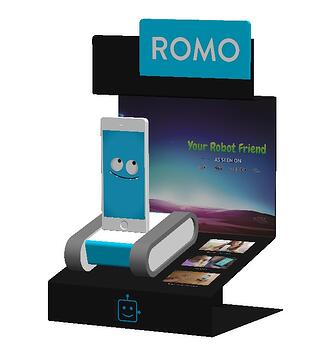In many cases we find that when we design retail POP displays for our customers, they are not one-size-fits-all. In other words, different retail environments often necessitate different point-of-purchase displays or variations of a core display concept. In today’s blog we’ll discuss one example of how we started with an awesome display and then modified it for other retail accounts and budget requirements.
The example we will use is a countertop display we designed and manufactured for Romotive. Our initial assignment was to create a cool outer space-themed display for Romotive’s friendly personal robot called Romo. The display was part of a chain-wide rollout in Brookstone stores. We created the display shown below.
The main body of the display was constructed by heat bending acrylic. We added a space-age plastic dome that was used to showcase a live Romo robot. The robot was programmed to move around inside the dome, show facial expressions, and demonstrate its personality. Inside the dome we included a molded latex moonscape and LED lights. The display had many other features including extensive vinyl graphics, a digital media player, an LED-lit logo, a rear access panel, and a number of other features. Several of these key design elements can be seen in the pictures below.
The picture below shows the Romo display in a Brookstone store.
In the course of developing the initial POP display for Brookstone and also subsequent to the successful rollout, we create a number of other versions of the display for other retail environments. For example, Romotive was interested in a more cost-effective version for a number of less upscale retailers. To hit a lower price point we substituted a square acrylic case for the plastic dome, eliminated some of the LED lighting, and compromised on a few other design elements. The result was not as cool, but the version of the display shown below was considerably less expensive yet still effective.
We developed an even lower-end version which we called the “T-Stand”. This was simply constructed using MDF with digitally printed back panel graphics, an LED-lit logo, and a 7” digital media player. The video did a good job of explaining the product so for this version we decided that we could get away without including a demonstration robot. This version was significantly less expensive than the other versions.
Finally, we created yet another variation of the display for the international market. The display below, for example, was designed to work for multiple international markets with smaller amounts of shelf space than the company was accustomed to getting in the U.S. We eliminated the digital media player and created a basic bent acrylic structure. We used graphics to tell the story (translated into the local language) and added a secure Romo unit to the display so interested customers could touch and feel the product.
Each of the Romo display options was specifically tailored to meet the needs of the retail accounts that Romotive was targeting. Understanding retailer needs and requirements was an important part of the process of ensuring that the displays would be effective across a diverse set of retail environments.

Jim Hollen is the owner and President of RICH LTD. (www.richltd.com), a 35+ year-old California-based point-of-purchase display, retail store fixture, and merchandising solutions firm which has been named among the Top 50 U.S. POP display companies for 9 consecutive years. A former management consultant with McKinsey & Co. and graduate of Stanford Business School, Jim Hollen has served more than 3000 brands and retailers over more than 20 years and has authored nearly 500 blogs and e-Books on a wide range of topics related to POP displays, store fixtures, and retail merchandising.
Jim has been to China more than 50 times and has worked directly with more than 30 factories in Asia across a broad range of material categories, including metal, wood, acrylic, injection molded and vacuum formed plastic, corrugated, glass, LED lighting, digital media player, and more. Jim Hollen also oversees RICH LTD.’s domestic manufacturing operation and has experience manufacturing, sourcing, and importing from numerous Asian countries as well as Vietnam and Mexico.
His experience working with brands and retailers spans more than 25 industries such as food and beverage, apparel, consumer electronics, cosmetics/beauty, sporting goods, automotive, pet, gifts and souvenirs, toys, wine and spirits, home improvement, jewelry, eyewear, footwear, consumer products, mass market retail, specialty retail, convenience stores, and numerous other product/retailer categories.








